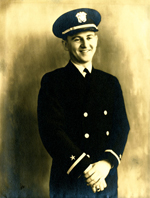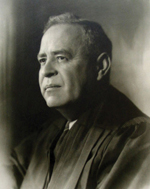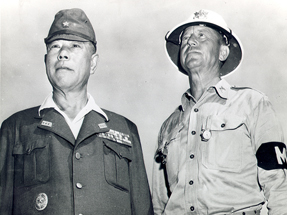Setting Precedent In Two Wars

A young Ensign John Paul
Stevens in naval uniform,
circa 1942-45.
John M. Ferren was wandering the hallways of the U.S. Supreme Court building, examining the justices’ portraits, searching for Wiley B. Rutledge. A justice from 1943 to 1949, Rutledge was the subject of a book Ferren was busy researching. The portrait was missing. It didn’t take long to find. “It was hanging,” says Ferren, himself a senior appellate judge, “in Justice John Paul Stevens’ chambers.”
Stevens’ law clerks know about the Rutledge portrait. They also know that when their term is up their boss presents them with a picture signed, “To my friend and former law clerk, with appreciation and affection.”
It is the same salutation that Rutledge wrote at the end of the 1947-48 term when his law clerk - a young Stevens - left to make his way.
The portrait and salutation aren’t the only things borrowed from Rutledge. Stevens has emulated his mentor’s modest persona and judicial philosophy, as well as his straightforward style.
“It’s quite clear that Rutledge is an important figure in his life and development as a lawyer,” says former Stevens clerk Diane Marie Amann, a law professor at the University of California at Davis. “He is dipping into the well of experience that he got in the year he worked for Rutledge.”
But it is Stevens’ revival of Rutledge’s opinions in cases involving war crimes, enemy combatants and the president’s wartime powers that has served as one of the most remarkable developments in the court’s history.
While court majorities in the 1940s pressed for swift prosecution of German and Japanese war prisoners through controversial military tribunals, Rutledge declined to join, instead issuing eloquent, highly reasoned dissents favoring the defendants’ due process rights. Almost 60 years later, in another conflict involving executive authority and captives of war, Stevens has managed not only to revive his mentor’s dissents but to use them to craft majority holdings in two prominent cases on the fate of Guantanamo Bay detainees: Rasul v. Bush (PDF), 542 U.S. 466 (2004), and Hamdan v. Rumsfeld (PDF), 126 S. Ct. 2749 (2006).
In addition, Stevens has called on Rutledge’s opinions in writing his own dissent in another terrorism-related case, Rumsfeld v. Padilla (PDF), 542 U.S. 426 (2004).
And in April a 1947 Rutledge concurrence, for which the young clerk wrote a memo, figured in the court’s denying - reluctantly, and with a warning to the government - Guantanamo detainees’ bids for review. Boumediene v. Bush (PDF), No. 06-1195, and Al Odah v. U.S., No. 06-1196. The court has since reconsidered and granted cert.
“Stevens has taken a leadership role in these cases,” says Temple University law professor Craig Green, who wrote about the two justices last year in the Washington University Law Review.
“He has enormous talents as a justice in putting together majorities,” Green says. “And he is working with Rutledge-based arguments that have a strong force in principle, and that speak to American values.”
“I call it a reaffirmation,” says University of Oklahoma law professor Joseph T. Thai, also a former Stevens clerk.
“It’s amazing how the stars have aligned so that the opinions that Rutledge wrote more than 50 years ago are now being vindicated.”
Adds Amann, who wrote about Stevens for a Fordham Law Review symposium last year: “There is this remarkable symmetry between the challenges that Rutledge was facing in the era that he was a justice and the challenges that Stevens is facing today in a post-9/11 world.”
Green takes the notion of symmetry a step further. “It’s unprecedented,” he says. “There have been several justices who were former law clerks, but none with the connections” like those that have been observed between Stevens and Rutledge.
OLD TAKE ON NEW CASE

A personalized portrait of
Supreme Court Justice Wiley
Rutledge, given to Stevens at the
end of his clerkship.
Perhaps no terrorism case reveals those connections as clearly as Rasul. Decided in June 2004 by a 6-3 vote, the case allowed detainees at Guantanamo Bay to challenge their imprisonment in federal courts, even though the detention center on Cuban soil is not under the “ultimate sovereignty” of the U.S. In an opinion written by Stevens, the court extended the federal habeas corpus statute to allow courts to grant writs, in certain circumstances, beyond their immediate jurisdictions.
In fashioning his opinion, Stevens revealed the depth of his homage, unearthing one of Rutledge’s most strident dissents and raising it to form his holding. In Rasul, the Bush administration relied heavily on Johnson v. Eisentrager (PDF), 339 U.S. 763 (1950), a key post-World War II case involving 21 German nationals who were captured in China, tried and convicted there by an American military commission, and jailed in Germany.
The case held that the capture, trial and punishment of the Germans all occurred outside the territorial jurisdiction of any U.S. court. The government argued that this was precisely the case at Guantanamo, where foreign nationals, captured overseas, were being held on a U.S. base that resides, however, on Cuban soil.
But Stevens, writing for the majority, swept Eisentrager aside. He noted that the Rasul detainees hadn’t been charged, much less convicted of any wrongdoing. He noted also that a 1903 lease agreement with Cuba granted the U.S. what amounted to sovereign control of Guantanamo.
Even the questions raised by a 1948 case that denied D.C. Circuit jurisdiction to 120 Germans held for deportation at New York’s Ellis Island (Ahrens v. Clark (PDF), 335 U.S. 188), Stevens noted, had been overruled in 1973. Braden v. 30th Judicial Circuit Court (PDF), 410 U.S. 484.
In Ahrens, Justice Rutledge had vigorously dissented (PDF). The Ellis Island prisoners, he wrote, “seek to avoid deportation from a country which takes care for personal liberties… to one which denied its own citizens such rights until its structure of tyranny fell in ruins.”
To that end, Rutledge argued, a habeas writ in certain circumstances ought to apply to the jailer, not to the location of the jail. And he concluded on a prescient note:
“The full ramifications of the decision are difficult to foresee. … Not the least important of these may be instances arising in the future where persons are wrongfully detained in places unknown to those who would apply for habeas corpus in their behalf. … Such a situation might arise from military detention … or possibly, though it is to be hoped not often, even from willful misconduct by arbitrary executive officials overreaching their constitutional or statutory authority.”
In a speech three months after Rasul, Stevens acknowledged the effect of Rutledge’s dissent. “Many observers wrongly assumed that [Eisentrager] would control the outcome of our Guantanamo decision,” Justice Stevens told the Chicago Bar Association. “Thus the Rutledge dissent written in 1948 significantly influenced an important case decided less than three months ago.”
Perhaps that’s not surprising, says Thai, who is researching Rutledge’s papers. As his law clerk during that term, Stevens’ memo on the case informed most of Rutledge’s argument.
“Stevens might have had those views, but Rutledge gives him the voice,” says Thai.
Stevens returned to Ahrens in his own dissent in Rumsfeld v. Padilla, another 2004 case involving habeas rights, enemy detainees and executive power. Padilla, an American citizen, was denied a writ filed in federal court in New York City while he was being held as an unlawful enemy combatant in a naval brig in South Carolina. And Stevens ended his harsh analysis of the majority opinion with a flourish reminiscent of Rutledge:
“At stake in this case is nothing less than the essence of a free society. … Unconstrained executive detention for the purpose of investigating and preventing subversive activity is the hallmark of the Star Chamber. … For if this nation is to remain true to the ideals symbolized by its flag, it must not wield the tools of tyrants even to resist an assault by the forces of tyranny.”
So formative was Ahrens to Stevens’ thinking that he used the case as the introduction in Mr. Justice Rutledge, a 1956 biography of his mentor written when Stevens was a lawyer practicing in Chicago.
“If there ever was a man whose principles and whole mode of living were the antitheses of Nazism,” Stevens wrote, “it was Wiley Rutledge.”
MAN OF THE PEOPLE
So just who was Wiley B. Rutledge? He is not among the most celebrated justices; his death in September 1949, only six years into his tenure, kept him from establishing the kind of legacy his longer-serving brethren achieved. And those larger-than-life colleagues—Robert Jackson, Felix Frankfurter, William O. Douglas and Hugo L. Black—had egos to match.
By contrast, Rutledge was an everyman. On a court full of feuding prima donnas, says Amann, Rutledge “provided the leavening. He was incredibly likable.” Wrote Stevens of his mentor: “He liked to travel by day coach because he enjoyed the conversation of his fellow passengers.”
A native Kentuckian, Rutledge rose through the ranks of academia to become law school dean at Washington University in St. Louis and at the University of Iowa. He was a Franklin D. Roosevelt loyalist whose devotion to the New Deal earned him a spot first on the U.S. Court of Appeals for the District of Columbia Circuit, then as FDR’s eighth and final appointment to the high court.
Rutledge opinions are generally praised as passionate and eloquent. “Rutledge had very strong convictions that he expressed in writing,” says Amann. “He wrote on 8-by-14 legal pads in flowery handwriting that enforces that passion and drama.” Adds Thai: “Rutledge was as eloquent as Jackson, who gets a lot more credit.”
The opinions are also known to be long, and Stevens took his boss to task for a style that at times, he wrote, was redundant: “He habitually used a pair of words where one would have served almost as well.”
And Rutledge was methodical. “It was extremely important for him to focus on the facts of each case,” says D.C. Circuit Judge Ferren, author of the 2004 biography of Rutledge, Salt of the Earth, Conscience of the Court. “He was not one who took an agenda, but he decided each case on its merits. He was an academician. He thought as he wrote.”
On the court, Rutledge was usually part of the liberal wing, often allying with Justice Frank Murphy, another FDR appointee whose even temperament matched Rutledge’s, says Amann.
But the cases that emerged from World War II began to prick Rutledge’s conscience. Rutledge reluctantly joined majorities in two famous—many would say infamous—Japanese-American internment cases, Hirabayashi v. U.S. (PDF), 320 U.S. 81 (1943), for which he wrote a concurrence, and Korematsu v. U.S. (PDF), 323 U.S. 214 (1944).
In a memo to Chief Justice Harlan F. Stone, writes Ferren, Rutledge said of Hirabayashi: “I have had more anguish over this case than any I have decided, save possibly one death case” on the appeals court.
DUELING IDEOLOGIES
The breaking point came over the controversial case of Japanese Gen. Tomoyuki Yamashita. In re Yamashita (PDF), 327 U.S. 1 (1946), revealed a fissure between those pressing for swift prosecution and punishment of captured enemy combatants and those urging the extending of traditional due process rights.
Yamashita earned the nickname Tiger of Malaya for his role in the 1942 conquest of the British colonies of Malaya and Singapore.
Toward the war’s end he was given charge of the retreating Japanese army in the Philippines. He took command of a northern division and assigned some officers to troops around Manila. Those troops went on a rampage, raping, torturing and killing thousands of Filipino civilians.
Yamashita was taken into custody after Japan surrendered in August 1945. The Americans charged that Yamashita “unlawfully disregarded and failed … to control the operations of the members of his command, permitting them to commit brutal atrocities.”
The allegations were virtually unprecedented and controversial from the start, Ferren writes. The American assertion of command responsibility held Yamashita liable for the atrocities, whether or not he ordered or even knew of the acts. His defense attorneys countered, among other claims, that neither American military law nor international articles of war recognized such a crime.
Yamashita was tried before a military commission of five generals, none of them lawyers, found guilty and sentenced to be hanged. The ruling was announced on Dec. 7, 1945, four years to the day after the Pearl Harbor attack.
Yamashita’s defense team appealed the commission’s jurisdiction, seeking habeas relief. According to Ferren, a furious Gen. Douglas MacArthur insisted that military procedures allowed review only by an appointed general, and then by MacArthur himself.
The Supreme Court agreed to hear arguments in the first week in January 1946. On Feb. 4, the court denied Yamashita’s claims. In his majority opinion, Stone said that military commissions had, at least, the implicit recognition of Congress, and that the charges had historical support.
Few cases had received as much publicity, and fewer still provoked the kind of detailed and principled dissent issued by Rutledge, held by many to be among the court’s finest. Stretching 40 pages, it was thorough and workmanlike, but nevertheless contained some of the court’s loftiest language:
“I cannot accept the view that anywhere in our system resides or lurks a power so unrestrained to deal with any human being through any process of trial. What military agencies or authorities may do with our enemies in battle or invasion, apart from proceedings in the nature of trial and some semblance of judicial action, is beside the point. Nor has any human being heretofore been held to be wholly beyond elementary procedural protection by the Fifth Amendment. I cannot consent to even implied departure from that great absolute.”
Privately, writes Ferren, Rutledge wrote to a colleague: “I think the decision was the worst in the court’s history, not even barring Dred Scott.”
Two weeks later, Yamashita was executed. And 60 years later, Stevens invoked Yamashita.
‘LONG AND VOCIFEROUS CRITIQUE’

Japanese Gen. Tomoyuki
Yamashita is escorted by a military
policeman in Manila in 1945
at his arraignment for war crimes.
In his majority opinion in Hamdan, stevens held—among other rulings—that the Guantanamo military commission was not expressly authorized by Congress, and that its procedures violated the Uniform Code of Military Justice and the Geneva Conventions.
Twice citing Rutledge’s dissent, Stevens pointed to Yamashita as aberrant—a “glaring historical exception” that “has been stripped of its precedential value.”
As he did in Rasul, Stevens evoked his mentor: “The procedures and rules of evidence employed during Yamashita’s trial departed so far from those used in courts martial that they generated an unusually long and vociferous critique from two members of this court,” those members being Rutledge and Murphy.
In April, Stevens cited yet another Rutledge opinion in turning down two Guantanamo Bay prisoners’ petitions to the Supreme Court. In statements denying cert for Boumediene and Al Odah, he and Justice Anthony M. Kennedy wrote that detainees must run the course set by Congress. But they warned that the government ought not erect hurdles or otherwise “take additional steps to prejudice the position of petitioners in seeking review in this court.”
The reference was to Rutledge’s concurrence in Marino v. Ragen (PDF), 332 U.S. 561, a 1947 case about the habeas process in Stevens’ home state of Illinois, then a Byzantine system in which the petitioner had little idea which motion to file and where to do so. Amann says Rutledge based his opinion on a memo from law clerk Stevens, which bemoaned a “procedural labyrinth [that] is made up entirely of blind alleys.”
“They are kindred spirits,” says Amann, who clerked during the 1988-89 term. “It’s not uncommon for Supreme Court clerks. You spend the rest of your career making decisions about the law. So it’s always a yardstick, a place that you go back to.”
As a naval officer, Stevens was awarded the Bronze Star for his service as a codebreaker. Amann says that experience—as well as his special view of the World War II cases—has helped him forge majorities in the two Guantanamo cases.
“It’s not surprising that at least some justices would have looked back at the World War II cases, at least to refer to history,” says Thai. The lesson of those cases, he adds, is that “the court got it wrong in World War II. They allowed the pressures for swift justice to lead them to abandon their function as a judiciary and uphold the rule of law. So, of course, they’re sensitive to repeating history.”
Says Green: “You don’t see a lot of pushback when Stevens invokes Rutledge. On the merits of his argument, Rutledge is better than his contemporaries.”
In Yamashita, Rutledge ended his dissent with a quote from Thomas Paine: “He that would make his own liberty secure must guard even his enemy from oppression; for if he violates this duty he establishes a precedent that will reach himself.”
In U.S. v. Alvarez-Machain (PDF), 504 U.S. 655 (1992), a federal court was given jurisdiction to try a Mexican national who had been forcibly kidnapped and brought to the U.S. In dissent, Stevens said sanctioning such an abduction compromised American justice, concluding with the same Paine quote.
“The lyrics are slightly different,” says Green. “But they’re singing the same song.”
Correction
In “Setting Precedent in Two Wars,” September, John M. Ferren was identified as a D.C. circuit judge. He is a senior judge on the D.C. Court of Appeals.The Journal regrets the error.



